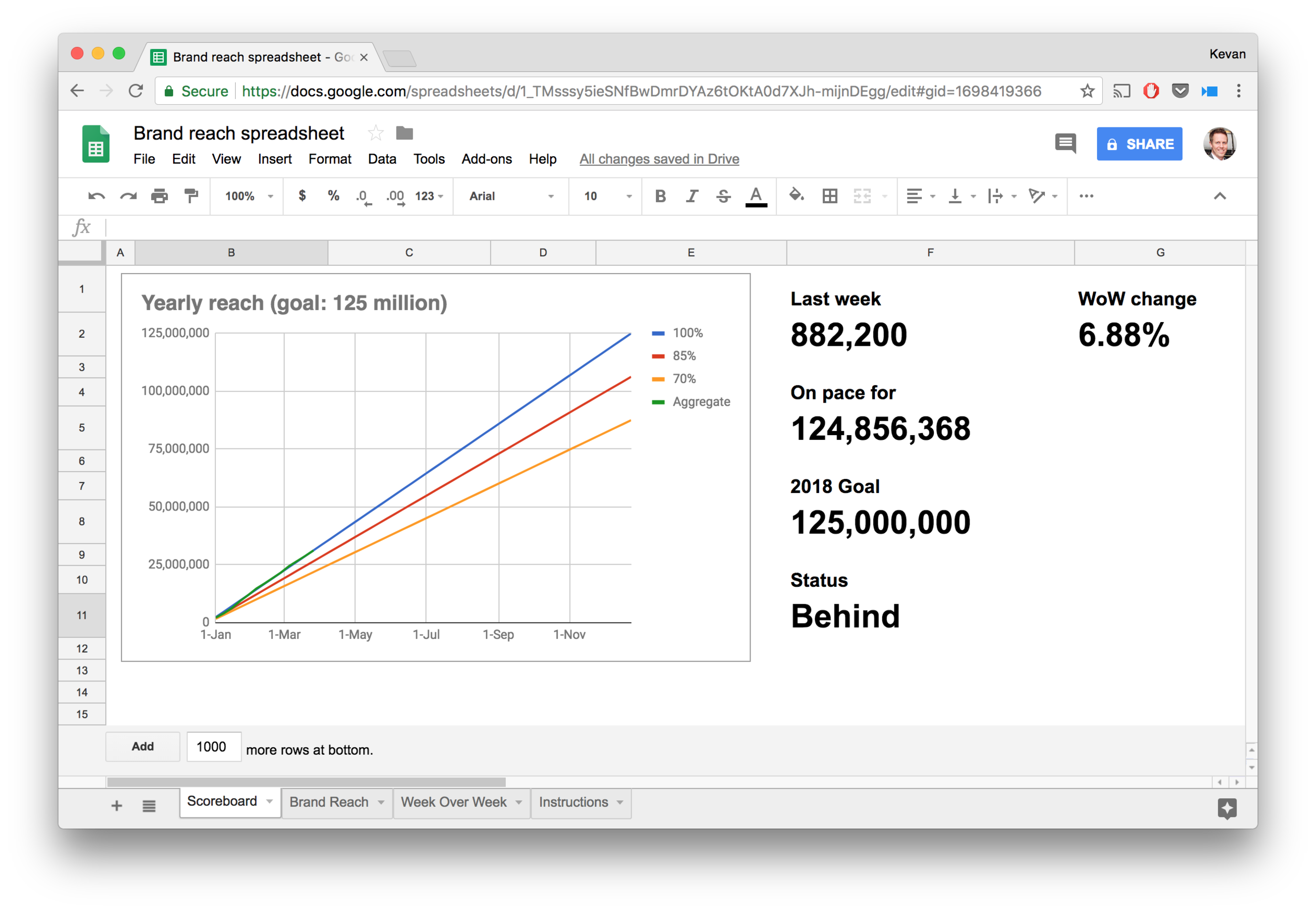How to calculate brand reach (w/ spreadsheet included)
Brand reach --- the number of people who see you and hear about you --- is the ethereal power behind the success of most every major brand. It is a flywheel, a wind in the sails, an invisible hand. And it's kinda hard to measure.
There’s not a lot of industry best practices about measuring brand reach. Measurement is more art than science: specific numbers aren’t as obvious to track or as necessary to report.
In many cases, this is freeing.
You can do creative, innovative brand projects that reach a lot of people (probably) and not have to worry about the almighty ROI.
In other cases, it's a bit dangerous and deflating if you can never measure --- and, therefore, never learn from --- your work.
At Buffer, we have ebbed and flowed in this stasis over the years. Today, we're much closer to a full understanding and tracking of brand reach. I'd love to share with you where we landed and to help you and your team measure the awesome work you do to spread the good word about your brand.
If you're keen to grab the spreadsheet template, here's a quick link. Much more info below.
Our aim is to still do useful, innovative, on-brand projects that spread far and wide. But we do like to be data-informed about how they’re going.
To this end, our Buffer brand marketing team came up with an aggregate reach number that we can track across all our various awareness channels.
For our purposes, here is the definition we use for brand reach:
Reach = The number of people who come in contact with the Buffer brand
The way we approached it was pretty straightforward:
What channels do we own that allow people to find out about us?
How can we best measure the size of these channels?
In some cases, like our blogs, this was obvious and easy. In other cases, like social media, this was ambiguous and open to interpretation. And ambiguity is okay. The thing about brand reach is that you will never know for certain an exact number of people who come in contact with your brand. The goal of measuring is to set a baseline, track your progress, and understand how you're doing.
With that in mind, here are the specifics of how we track and how we define "reach" on all our different channels.
Our brand reach spreadsheet
You can get this free brand reach template on Google Sheets. It's based on the one we use every day at Buffer. Just make a copy of the spreadsheet to edit it yourself ("File > Make a copy").About the spreadsheet:
You only have to update the individual channel numbers each week.
The charts and graphs are updated automatically.
That fancy graph is called a waterfall graph.
Our brand reach definitions
On the Week Over Week tab of the spreadsheet, we update our stats every Monday for the week prior. This is a simple process that takes only a few minutes per teammate. It took us a bit longer to come up with the definitions below, and I'm happy to share them with you. Once you have these definitions in place, tracking becomes a breeze.
Blog and content marketing
Blog Sessions:
A session begins when a person first visits any page on the blog; the session ends when the person navigates away from the blog, closes the browser tab, or after 30 minutes of inactivity or at midnight. A single session can contain multiple pageviews, events, interactions, and transactions.
Blog Users:
The total number of both new (new to the Buffer blog on a specific device) and returning (returning to the Buffer blog on a specific device) users that have had at least one session within the selected date range.
Users is a smaller number than sessions, because a single user may have multiple sessions within a given window of time.
The more accurate way to report the reach of a blog would be to use "users" instead of "sessions."
All sessions and users are tracked in Google Analytics.
Social media marketing
Social Impressions:
The number of times our content is displayed within a social media feed, no matter if it was clicked or not.
Social Reach:
The total number of people who see our content within a social media feed.
Impressions also count multiple views by the same person to a single piece of content. For example, if one user saw the same piece of content twice, that would count as two impressions.
Reach does not count multiple views to a piece of content. For example, if one user saw a piece of content ten times, that would count as one reach.
We track reach and impressions using the native analytics from the social networks and the analytics from Buffer.
Social Engagement:
The cumulative total of likes, comments, shares, and clicks to a single post or a channel as a whole.
For example, 50K engagements on Facebook in March 2018 would mean: 50,000 total likes, comments, and shares to all Facebook posts in March.
We can get these numbers natively from each social network or from the Buffer dashboard.
Multimedia
Video Views:
The total number of times a single user or users watch videos posted to Facebook, YouTube, and Twitter.
Each channel defines a “view” differently:
Facebook: Defined as a view of three seconds or more (does not need to be 100% in-view. I.e., can be playing above or below posts. Video plays until post is fully out of view in feed )
YouTube: Defined as a view of 30 seconds or more
Twitter: Defined as a view of three seconds or more (does need to be 100% in-view. I.e., it requires a user click-to-play. If user scrolls away, video stops.)
Podcast Downloads:
The number of downloads to unique devices (Desktop, iOS, Android) as reported by Libsyn.
Downloads are only counted once per account. For example, 14K downloads means that 14,000 unique users downloaded our episode to their device.
Community and engagement
Slack community:
The total number of members in the Slack community.
We've also tried tracking daily active users (DAUs) and monthly active users (MAUs) in the past but didn't find those stats to be fully reliable.
Social media Conversations:
the total number of replies and/or conversations the marketing team engages in
We use Reply to manage our social media conversations, and there are particular folders that marketing owns. We add up the totals from these folders.
Press
PR
Reach is calculated using Meltwater, a PR tool that gives us the total monthly reach of the section of an outlet we were featured in. (Ex. FastCompany’s Leadership section.) We take 2% of that number (for the percentage of audience we can estimate we reached, this is a PR industry acknowledged percentage) and then divide by 4 to get the weekly number.
Example: FastCompany’s Leadership section reached 37 Million people in a month, we were featured there once. 2% of 37 Million is 740,000 reach for the month. Divided by 4 we have 185,00, which is the reach I would report for the week we were featured.
Syndication:
The total views that our syndicated content has received. This is based on Meltwater’s reporting and uses the same formula as PR.
Medium Views:
The number of total clicks to any one of our stories. In other words, users intentionally clicked to open the story.
Campaigns
The total cumulative reach (see above) for all one-off projects and/or campaigns that we run as a team.
These are different than areas that we own such as: social media, PR, community, podcast, video, etc. Campaign totals include all metrics within a given time period: blog sessions (Open and/or Social), social media reach, PR, etc. We would then subtract those numbers from their respective areas.
For example, if a campaign reached 50,000 people on social and received 50,000 sessions to the blog, that would count as 100,000 total campaign reach - and we would subtract 50,000 from social reach and open blog sessions for the time period.
Over to you
Any questions on our process?
Thanks for giving this article a look. And huge thanks to my Buffer teammates for pioneering this brand tracking and measurement.

